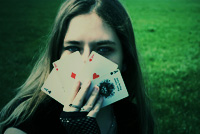Understanding Patterns of Your Opponent to Make Better Decisions
For beginners it is important to be able to spot a tell and learn how to use it for their advantage. This article talks about spotting betting patterns in an opponent.
BETTING PATTERNS

Watching how an opponent plays a hand can give away a lot of information.
Check Raise
When a player checks a hand and then raises it after another player puts a bet on it, it’s usually a strong hand. However, if your opponent is someone who would check raise on almost anything then you would want to call on that raise if you have a flush or a straight. Some players would also check raise to bluff, if you know your opponent well and know that he bluffs often then you should call or even raise with weak hands too.
Placing a bet
There are a few players who would bet if the opponents check, even with a weak hand. If you flop strong cards and you are against this kind of an opponent you must check and then re raise, this will chase your opponent away and also increase the pot size.
Betting size
Keeping an eye on how much your opponents bet can reveal a lot about them. A player would under bet when he/she has a strong hand and doesn’t want to scare opponents away. If you come across that kind of a player and he under bets then you might as well fold. A sizeable bet, two or three times the size of the pot is an over bet. If you know where your opponent has used it before you would know that he would over bet only when he has really good hands and in that case you should fold.
OTHER BETTING PATTERNS
• An opponent who always plays slow when he has an Ace or Kings pre-flop.
• He would never fold a hand after the flop, turns or river if he has Aces or Kings.
• He would always over bet pre flop if he has Aces or Kings.
• He always places a continuation bet after the flop is dealt.
• He would only re raise against weaker players.
• He would only call with very strong hands.
Now consider a friendly table with no limit where you are dealt a pair of jacks on your first hand and there has been a raise and a re raise by the time it’s your turn to act. If you are playing against wild, careless players it would be good to raise in a situation like this and if you are playing against tight players you might only want to call or even just fold. Without knowing the patterns of your opponents, when you are just beginning at a table you can usually get an idea about them by just taking a closer look at your opponents.
Stacks of chips
A player who generally tends to neatly arrange his stacks of chips or builds a nice looking formation out of his chips usually doesn’t get involved in a lot of hands. Players who keep their chips randomly would be the one playing in all hands imaginable. Neat chip stacks usually mean a conservative player, random and sloppily arranged chips means a loose player.
Talk at the table
If you come across an opponent at a table who talks too much and appears to be sociable then he would generally be playing more pots and would be playing quite loosely compared to the conservative tight players.
Tight play
A player with folded arms or the one who would be listening to some music or sitting back in a chair would generally be a tight player.
Loose Play
A player who is very sociable, drinks a lot during play and behaves outrageously is a loose player.




